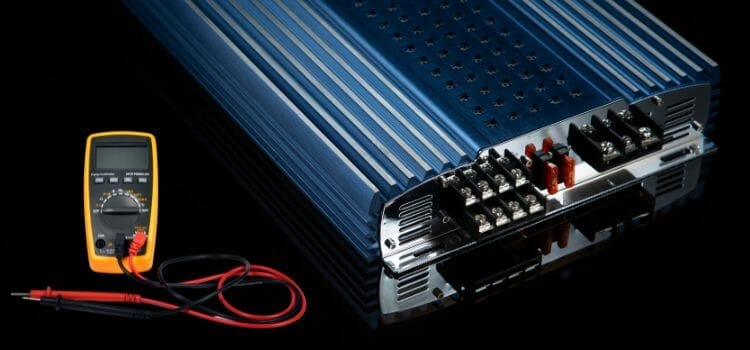How To Test A Car Amplifier With A Multimeter? In Just 5m
Nowadays everyone listens to music in the car. Many of us want to listen to loud and clear music. Just imagine if you have a car trip and you do not have a good music system in the car.
Would you enjoy the trip? Of course not.
A car amplifier is an electronic device that assists in improving the listening experience. Moreover, it helps the loudspeaker in producing a loud and clear sound.
Whether you want to set up a music system in a car. First, you have to understand the appropriate method then go for it. If you want to learn the processes read all the paragraphs that are below.
Every query that is related to how to test a car amplifier with a multimeter is a debate that can assist you.
Read Also: Making a Car Amplifiers More Powerful Guide
Things You Will Need For This Process:
- RCA cable
- Multimeter Cooling fan (optional)
- Multimeter
- Amp
How To Test A Car Amplifier With A Multimeter?
Here is the Easiest Way to Test a Car Amplifier with a Multimeter Step by Step
You can see below the complete method of testing a car amplifier with a multimeter. There is nothing difficult about testing a car amplifier. We have to follow only a few steps to test an amplifier.
1. Configure The Multimeter
Before going to the actual process first we need to configure the multimeter. There is not nothing difficult to configure the multimeter. If you are even new to this.
The back probe has to move into the ordinary socket (occasionally, labeled COM). While the red proceeds in the A labeled socket. A stand for amperage.
There is a possibility to find two different sockets. One socket is more sensitive while the second is high amperage. If you are confused about which one to try, use the second socket with the highest rating.
Move the central dial to the amperage of the multimeter which sets the corresponding socket. A small chance is there of these settings look different, but so far the same thing they mean.
2. Testing the Amplifier
Now Let’s move to the actual steps.
Step1: Find the amplifier’s location in your vehicle
A car amplifier is able to be found behind the seat or on the dashboard or anywhere else. Find the exact location of the amplifier built-in to your car. Read the manual of your car and then look for it.
Step 2: Test the fuse of the car amplifier for power
Check the fuse of a car amplifier for the power and also check the voltage of the fuse attached to the amplifier
Step 3: Check the amplifier protection mode
Check the wiring system and installation of the amplifier whether it works properly or not.
We have to disconnect all the connections to check the amplifier and then on the amplifier. If the protected mode is on it means, there is a fault.
Connect an amplifier with a multimeter and check the wiring issue by checking the voltage coming from the wire connecting to the amplifier.
Step 4: Verify the output
To plug the multimeter wire into the output channel you have to simply. Let’s check the multimeter reading. If it’s not showing any reading, then it means your speaker has blown.
Step 5: Check the signals of your amplifier
The signals are checked from the amplifier by attaching it to the amplifier. The amplifier definitely will cause distortion if the signal on the amplifier is fluctuating.
Step 6: Check the voltage coming from your amplifier
The voltage has to be checked that comes from the amplifier. Check the voltage by attaching the amplifier with a multimeter. If the amplifier goes off the voltage source has to be checked.
There can be another case that might show your amplifier shows a voltage of fewer than 10 volts. There is a possibility of harming your amplifier and a technician’s look is better for it.
How Does Multimeter Work And Types Of Multimeters?
There are many individuals unaware of electronics and their usage. Whether you are one of them then learn about it properly before using it.
We use a multimeter to solve the problem of electric and electronic devices. A multimeter is an electronic device that is used to measure current, resistance, and voltage in an electric or electronic circuit.
Basically, it is used to check the proper operating level. Multimeters are of two types; one is a digital multimeter and the other is an analog multimeter.
Yes, we are able to use a multimeter to test a car amplifier. For this, we use the amplifier at VDC mode, set the wire, check the amplifier fuse along with the output, and check the voltage.
Digital multimeter is used widely due to the fact that they are much more user-friendly. Furthermore, it also shows results in digits which reduces the error while reading the result.
In addition to measuring voltage, current, resistance, frequency, and signal power, analog multimeters can also be used to measure other electrical quantities.
Basic functionality includes measurement of potential in volts, resistance in ohms, and current in amperes.
Amplifier Has 3 Major Parts:
- Power
- Input
- Output
Let’s take a look at each one in detail.
1. POWER:
Power amplifiers (PAs) convert low-power signals into high-power ones.
An audio amplifier, which drives loudspeakers and headphones, and an RF power amplifier, which is used in the last stage of the transmitter, are two common examples.
2. INPUT:
The power amp input connection feeds the unit’s internal amplifier, which in turn drives any speakers that may be connected (either internal or external).
Normally, The amplifier power input is found in a preamp output _ the two-connection complementing when it is used to form a simple effects loop together.
3. OUTPUT:
A sine wave is produced by the amplifier (Trace A, Figure 32.36) with about 1.5% distortion (Trace B).
There is almost exclusively a common mode swing in the amplifier that is responsible for the relatively high distortion content. A high-frequency op amp suffers from common mode rejection, resulting in distortion of the output.
Read Also: Tuning a Car Amplifier For Mids & Highs – In Only 5m
Frequently Asked Questions
Here are some related questions asked by every individual.
Q: What Is The Output Voltage Of An Audio Amplifier?
A: The power of a system is equal to the voltage squared divided by the resistance.
An amplifier’s speaker output measures 10 volts AC with a constant sine wave input. Based on the resistance (5 ohms) and voltage (10 volts), you can calculate the power: Power = (10 times 10) divided by 5 = 100/5 = 20 watts.
Q: How Can You Tell If An Amp Is Blown?
A: The most common aural indication of a blown amp is an unpleasant buzzing or scratching sound, by itself or roughly at the pitch of the note the speaker is attempting to reproduce.
Secondly, there may be no sound.
Q: How Do I Test Dc Amps With A Multimeter?
A: Both AC and DC currents can be measured with a multimeter by connecting the meter in series with the circuit, in which the current is measured provided the current in that circuit is limited or controlled by a load or appropriate values of resistance.
Q: How Do You Test An Amplifier To See If It Works?
A: Here is a quick guide:
1. Attach the wires for power (red) and ground (black).
2. Touching the amplifier’s electricity wire to the car’s battery positive post and the ground to the negative battery post is one of the easiest things.
3. The amplifier should be linked- with a mic.
4. All accessible fuses should be checked, and one amplifier fuse should be used.
Conclusion
The bottom line, learning how to test a car amplifier with a multimeter is relatively simple for someone with a touch of passion for technology.
There are only a few steps anyone can test themselves. By learning of it. They are capable of connecting the amplifier with the car loudspeaker to listen to clear sound.
Thanks for reading, that being said have a nice day!






